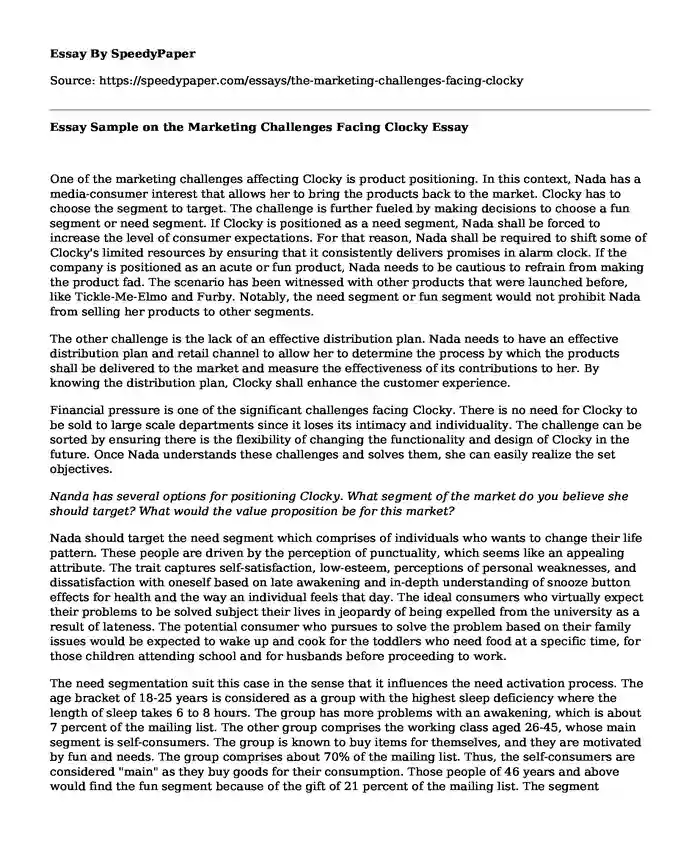
| Type of paper: | Course work |
| Categories: | Company Sales Strategic marketing Customer service |
| Pages: | 4 |
| Wordcount: | 842 words |
One of the marketing challenges affecting Clocky is product positioning. In this context, Nada has a media-consumer interest that allows her to bring the products back to the market. Clocky has to choose the segment to target. The challenge is further fueled by making decisions to choose a fun segment or need segment. If Clocky is positioned as a need segment, Nada shall be forced to increase the level of consumer expectations. For that reason, Nada shall be required to shift some of Clocky's limited resources by ensuring that it consistently delivers promises in alarm clock. If the company is positioned as an acute or fun product, Nada needs to be cautious to refrain from making the product fad. The scenario has been witnessed with other products that were launched before, like Tickle-Me-Elmo and Furby. Notably, the need segment or fun segment would not prohibit Nada from selling her products to other segments.
The other challenge is the lack of an effective distribution plan. Nada needs to have an effective distribution plan and retail channel to allow her to determine the process by which the products shall be delivered to the market and measure the effectiveness of its contributions to her. By knowing the distribution plan, Clocky shall enhance the customer experience.
Financial pressure is one of the significant challenges facing Clocky. There is no need for Clocky to be sold to large scale departments since it loses its intimacy and individuality. The challenge can be sorted by ensuring there is the flexibility of changing the functionality and design of Clocky in the future. Once Nada understands these challenges and solves them, she can easily realize the set objectives.
Nanda has several options for positioning Clocky. What segment of the market do you believe she should target? What would the value proposition be for this market?
Nada should target the need segment which comprises of individuals who wants to change their life pattern. These people are driven by the perception of punctuality, which seems like an appealing attribute. The trait captures self-satisfaction, low-esteem, perceptions of personal weaknesses, and dissatisfaction with oneself based on late awakening and in-depth understanding of snooze button effects for health and the way an individual feels that day. The ideal consumers who virtually expect their problems to be solved subject their lives in jeopardy of being expelled from the university as a result of lateness. The potential consumer who pursues to solve the problem based on their family issues would be expected to wake up and cook for the toddlers who need food at a specific time, for those children attending school and for husbands before proceeding to work.
The need segmentation suit this case in the sense that it influences the need activation process. The age bracket of 18-25 years is considered as a group with the highest sleep deficiency where the length of sleep takes 6 to 8 hours. The group has more problems with an awakening, which is about 7 percent of the mailing list. The other group comprises the working class aged 26-45, whose main segment is self-consumers. The group is known to buy items for themselves, and they are motivated by fun and needs. The group comprises about 70% of the mailing list. Thus, the self-consumers are considered "main" as they buy goods for their consumption. Those people of 46 years and above would find the fun segment because of the gift of 21 percent of the mailing list. The segment comprises people who buy items for others.
In this case, the customers would not purchase through the internet with a particular distribution needs channel. If the segment is intense or extensive, it can debilitate product positioning with other segments such as robotic pet options and design options. However, Nada should focus on people within the age bracket of 18-45 based on the following reasons; Research has it that people under the ages of 18-29 spend the least time sleeping. About 57% of the people aged 25-34 hit the snooze button per day, which implies that there cease to be any efficient snooze button alarm-clocks for this group. Studies also reveal that people under the age bracket of 35-45 usually have a job and a family which portrays their strong commitment to realizing their time deadlines.
Hence, Nada should focus on the people under the age bracket of 18-45 years as the main category. The reasoning is stemmed from the Percentage of 76 on the mailing list. About 23% of people in this category are said to have the intention of buying Clocky as a gift. Based on this concept, people can develop a reasonable approximation of the fun segment percentage. The ease in this approximation is supported by the fact that customers who purchase Clocky for their own consumption seek to change their wake up process.
In my view, therefore, the need segment would be the most appropriate segment to explore. Such that, it does capture not only the interest of people age 18-45 but also people above 45 years. In this case, these customers can be categorized under the need market.
Cite this page
Essay Sample on the Marketing Challenges Facing Clocky. (2023, Apr 12). Retrieved from https://speedypaper.net/essays/the-marketing-challenges-facing-clocky
Request Removal
If you are the original author of this essay and no longer wish to have it published on the SpeedyPaper website, please click below to request its removal:
- The Lottery - A Literary Essay Example
- Essay Example on International Human Resource Management
- Free Essay Sample on Media and Violence
- Essay Sample: Action Taken on John's Class Fighting Behaviour
- Essay Example on the Stakeholders of XYZ Zippers Company
- Understanding Crime in the Society, Essay Example for Students
- An Occurrence at Owl Creek Bridge by Ambrose Bierce. Paper Example
Popular categories




